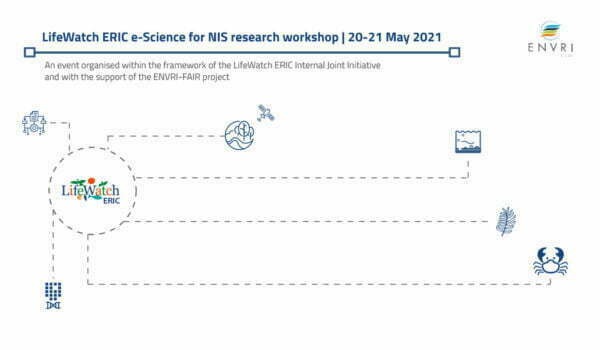
The 20–21 May was an important milestone for the LifeWatch ERIC, as it hosted its long-anticipated e-Science for NIS workshop, albeit in a virtual form due to the ongoing pandemic. The workshop was organised with the support of ENVRI-FAIR, and was hugely successful, attracting over 220 registrations. The aim of the event was to showcase the results of five research endeavours, known as validation cases, into Non-indigenous and Alien Species (NIS) conducted over the last 18 months within the LifeWatch ERIC Internal Joint Initiative.
These validation cases led to the development of five separate workflows, created through the joint effort of scientists and ICT experts, both from LifeWatch ERIC Common Facilities and Distributed Centres, to accommodate the data and analytical processes generally required by the NIS scientific community. In turn, these workflows have been integrated into Tesseract technical composability layer, the new Virtual Research Environment (VRE) platform being developed by LifeWatch ERIC. Both the innovative advances in technology and the associated scientific reports sparked engaged and enthusiastic discussion over the two days. In fact, the workshop proved to be particularly appreciated by attendees, with 85% rating it as “very good” or “excellent”, as well as the web-services presented also considered “very good” or “excellent” by 78% of participants.
LifeWatch ERIC is at the service of the biodiversity and ecosystem research community, and is constantly seeking to create opportunities for mutual exchange. For this reason, the presentations of the validation cases were complemented by a series of round tables, featuring academics and experts from a wide range of fields. The speakers debated the ecological, economic and social impact of NIS, and the need to work across disciplines, combining social and natural sciences. The final consensus was that greater coordination of data collections is required in order to integrate existing data from different sources, and find ways to enable access to such collections.
Non-indigenous Invasive Species have enormous impacts on ecosystem services, human health and on the economy. This is why LifeWatch ERIC was proud to present the results of the validation cases providing powerful and flexible workflows capable of integrating more data and services than has yet been possible. The workflows will be available in the LifeWatch ERIC Tesseract VRE, which among its many innovative functions, enable the import of data from different sources, their exploration in maps for validation, and the use of standard tools to connect data analytics through its HPC and cloud-related technologies. Tesseract is also built around the unique LifeWatch ERIC tool known as LifeBlock, which uses Blockchain technology to ensure the integrity of all data inputs and full recognition for contributors. The VRE is not only an innovative tool that can be customised to other bioregions, but it will continue to evolve in the light of future feedback from scientists. In the long run, the use of Tesseract will contribute to boosting social awareness about biodiversity and help policymakers concerned about habitat conservation to implement sound science-based decisions.
LifeWatch ERIC would like to take this opportunity to acknowledge the superb efforts of all the team members involved, and to thank ENVRI-FAIR Science Cluster for its support during the workshop, as well as all the wonderful speakers and participants who actively contributed to make this 2-day workshop a success and with whom LifeWatch ERIC hopes to continue working in the future.
The recording of the workshop will shortly be made available, in the meantime, you can find the workshop presentations here.